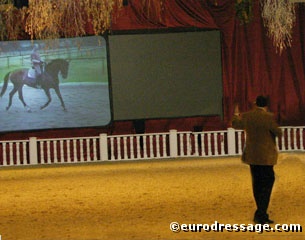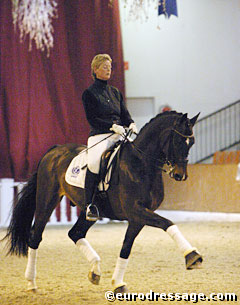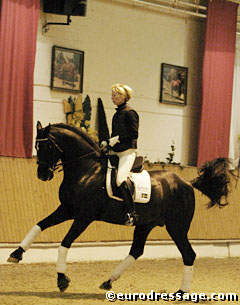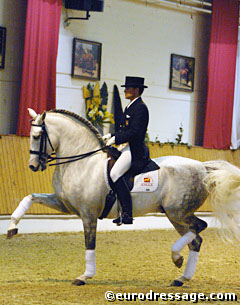
German freestyle composer Stephan Krawczyk tried to explain how the music's rhythm has to be equal to the beat of the horse's movements, by playing two video clips of Hubertus Schmidt riding Wansuela Suerte.
According to Krawczyk, a good freestyle shows movements reflected in the music. "You have to see what you hear," Krawczyk said.
He first showed a soundless video tape of Hubertus Schmidt riding his kur to music at his home in Paderborn, Germany. For Krawczyk, the composition of a freestyle starts with the choreography. Schmidt had created one to which Krawczyk added popular music to make the composition modern and catchy. He chose lyrics by German pop artist Hermann Gronnemeier and pointed out how different tunes from one genre of music gives more pizzazz to each movement.
Krawczyk's lecture at the forum was a bit unstructured and it was hard to understand the point he was trying to make when he showed the silent movie of Schmidt without giving educational comments. He made the most sense by stating that "it is more difficult to compete in the kur, because the rider has to perform to the music and not at definite points in the ring. That is the art of freestyle riding."
 To date, riding exactly to the music is considered to be an artistic accomplishment and a rider earns a higher score for it at the artistic level. One wonders if it not also fits the category of technical difficulty. How many riders are able to really make their music match their performance. Is it not mastery of technical riding skills to perform exercises right on the beat of the music?!
To date, riding exactly to the music is considered to be an artistic accomplishment and a rider earns a higher score for it at the artistic level. One wonders if it not also fits the category of technical difficulty. How many riders are able to really make their music match their performance. Is it not mastery of technical riding skills to perform exercises right on the beat of the music?!
A much more interesting discussion arose during Ann Kathrin Linsenhoff's demonstration on her new Grand Prix horse Sterntaler, an Oldenburg gelding by Sion. Linsenhoff did not ride a kur, but showed some Grand Prix movements. Her green Sterntaler showed great potential in the piaffe and passage as well as in the pirouettes. This was an incentive for Volker Moritz to start a debate on the pirouette. The judges like to see a few straight strides before and after the pirouette. The Gabrielle Grillo walk-pirouette transition is not longer preferred. "it's too much in the direction of circus," Moritz said.
David Hunt, president of the International Dressage Trainers Club (IDTC), wondered why the few straight strides are necessary when the horse has the ability to do a clear pirouette and taking into consideration that the pirouette is a bending exercise. Moritz quickly replied that "we follow the directives of the IDTC" which state that the "in" and "out" of a pirouette has to be on a straight line.
 The pirouette debate took a new turn when the experts talked about a movement consisting of a pirouette, followed by one or two straight strides and then a new pirouette. Is this allowed? Yes. Judge Stephen Clarke said that this exercise demonstrates a high degree of difficulty because of the collection.
The pirouette debate took a new turn when the experts talked about a movement consisting of a pirouette, followed by one or two straight strides and then a new pirouette. Is this allowed? Yes. Judge Stephen Clarke said that this exercise demonstrates a high degree of difficulty because of the collection.
Louise Nathhorst and her 15-year old Guinness were the illustrators for the flying changes debate. 9 flying changes are an absolute minimum in the freestyle. 15 are desired, 20 is even better if you have a horse that is very good at it. Heike Kemmer said that she could not do too many single flying changes because her horse Abano would get too hot. "Bonaparte is now at an age that we are trying to do more. The risk and difficulty of doing so many are higher if you ride more in the freestyle" Kemmer said. According to Withages, more flying changes is a higher degree of difficulty, but all changes have to be of good quality. Judge Dieter Schule said he very much likes the transition from 2x to 1x tempi's on the circle.
 Spanish Olympic team rider Rafael Soto brought two Spanish riders to the forum, Jose Antonio Garcia Mena and Ignacio Rambla, to pepper the topic of piaffe and passage, the trade mark of the Andalusian horse.
Spanish Olympic team rider Rafael Soto brought two Spanish riders to the forum, Jose Antonio Garcia Mena and Ignacio Rambla, to pepper the topic of piaffe and passage, the trade mark of the Andalusian horse.
Are judges influenced by using the best movement of a horse for the opening of the test; in case of the Andalusians by riding the passage. "We are not that easily impressed," was Withages' full-throated declamation.
Spanish former young rider Jose Antonio Mena rode three pirouettes on the centerline (D - X - G) with his 12-year old Andalusian stallion Lance. Is this a good exercise for a kur? Moritz said that if the technical execution is well done, the mark will go up, but he found it a quite boring choreography.